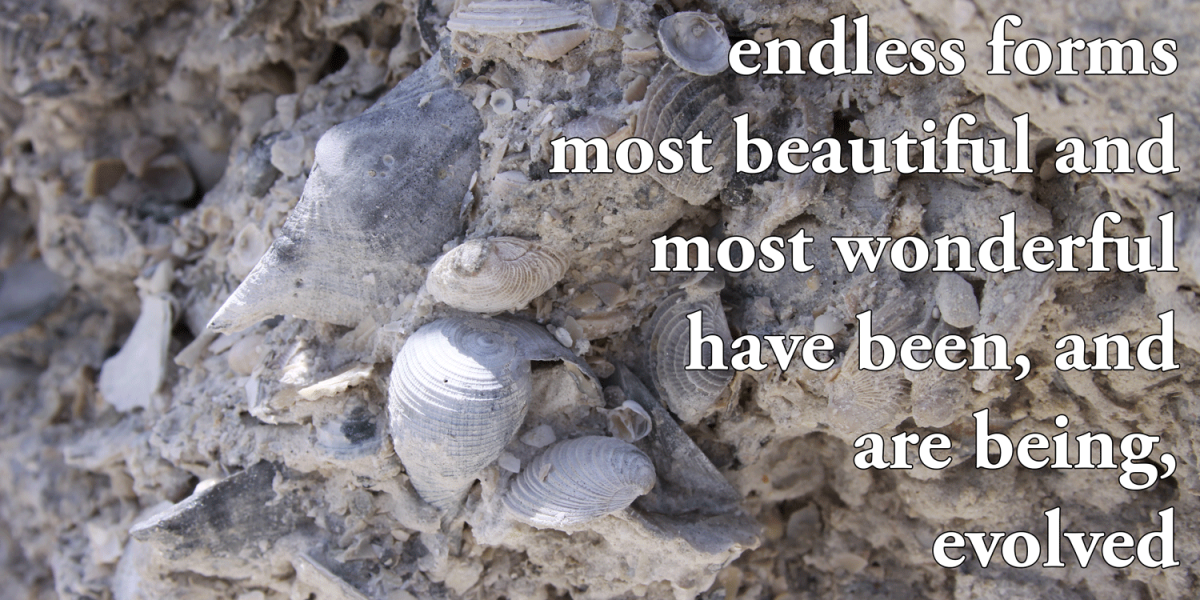Chapter by:
Jonathan R. Hendricks*, Paleontological Research Institution, Ithaca, New York
Bruce L. Lieberman*, University of Kansas, Lawrence, Kansas
* Authorship is alphabetical; both authors contributed equally to this work.
This chapter was first shared with the public on January 6, 2020. It was last updated on on January 6, 2020.
Chapter citation:
J.R. Hendricks and B.S. Lieberman. 2019. Evolution and the Fossil Record. In: The Digital Encyclopedia of Ancient Life. https://www.digitalatlasofancientlife.org/learn/evolution/
Chapter contents:
Evolution and the Fossil Record ←
– 1. Natural selection
– 2. Species and species concepts
– 3. Speciation
– 4. Punctuated equilibria and stasis
–– 4.1 Videos about punctuated equilibrium and stasis
– 5. Macroevolution
–– 5.1 Hierarchies
–– 5.2 Species selection
–– 5.3 Abiotic vs. biotic causes of macroevolution
–– 5.4 Evolutionary radiations
Charles Darwin concluded the first edition of his famous book On the Origin of Species by Means of Natural Selection with one of the loveliest passages ever written by a scientist:
There is grandeur in this view of life, with its several powers, having been originally breathed into a few forms or into one; and that, whilst this planet has gone cycling on according to the fixed law of gravity, from so simple a beginning endless forms most beautiful and most wonderful have been, and are being, evolved.
What led him to this stunning conclusion, that natural forces are responsible for life's great present and ancient diversity of lifeforms? What is the evidence that evolution has produced new species and has honed them to survive in the environments in which they live? How does evolution work and how does understanding of the fossil record inform our understanding of evolutionary processes? This chapter will explore these and other questions.
What is evolution?
In a biological context, the word evolution is best defined by three words: descent with modification. This means that all life forms have descended from an ancient, shared common ancestor and have changed over time to survive in the environments in which they live.
Other definitions exist and are valid, though are often too narrowly defined. If you have taken an introductory biology class, you may have learned that evolution means “changes in gene frequencies within a population.” Our definition above is broader and also more general. In particular, it focuses on a pattern of change (descent with modification), rather than the mechanisms or processes that are responsible for that change. Distinguishing between patterns and processes will come up again in our later discussion of "macroevolution."
Further, this broadly-focused definition of evolution allows consideration of not only genetic changes within populations, but also both larger and smaller scale evolutionary changes. Distinctions between phenomena occurring at different scales will become important later in the chapter when we discuss “hierarchies.”
What does evolution seek to explain?
Scientists who study evolution seek to explain two fundamental observations of nature.
First, they seek to explain the “goodness of fit” of organisms to the environments in which they live. A less fancy way of saying this is that scientists want to explain why organisms seem to be very good at doing what they do. Consider, for example, a squirrel. Its chisel-like teeth easily open the shells of hard acorns, its tail provides great balance as it runs along telephone wires, and its brownish-gray fur provides it ideal camouflage against tree trunks. Early naturalists attributed such goodness of fit to divine design. In fact, they carefully explored nature in order to discover evidence of God’s creation. It is from this school of study (known as Natural Theology) that Darwin’s idea of natural selection as an explanation for “goodness of fit”–better known today as adaptation–was first developed (we explore this in detail in the Natural Selection page of this chapter).
Second, scientists who study evolution seek to explain another fundamental observation of the living world: the great number of different species, or biodiversity. In short, why are there so many different kinds of plants, animals, and other lifeforms, and how did they come to be? We explore both the nature of species and the process responsible for their generation (speciation) later in this chapter.
Is evolution a fact or a theory?
Yes, it is.
Okay, what we actually mean is that it is both, and hopefully a bit more context will be useful. It turns out that whether we refer to evolution as a “fact” or a “theory” depends on if we’re speaking in a strict scientific sense or in the colloquial usage of these terms.
A “theory,” in scientific parlance, is best thought of as some extremely well-supported body of knowledge which can explain the behavior of, or relationships among, certain objects in the universe. One example of a scientific theory is the "germ theory of disease." This is the theory that some germs make humans sick. We take this as an obvious fact now, but just several hundred years ago, many attributed disease to evil spirits and other causes that seem strange to us now. Another example of a scientific theory is plate tectonics, which is the idea that the surface of the world is divided into a series of plates that interact at their edges, causing the formations of mountains and volcanoes, as well as triggering earthquakes. (It is probably worth noting, again, that not so long ago in human history, volcanic eruptions and earthquakes were sometimes attributed to supernatural forces). So, you can see that the scientific usage of the word "theory” is very different from its usage in day-to-day discourse, where it indicates a hunch or poorly formed idea (e.g., that the Cleveland Browns are going to win the Super Bowl next year).
To the general public, the term “fact” is often invoked to indicate something is absolutely and indisputably true. For example, brick walls are solid and that is a fact: even if you try to imagine that they don’t exist, that won’t help you if you decide to run into one (don't do it; it will hurt).

Portion of a Roman city wall built in the present location of the Tower of London. This wall was constructed around 200 A.D. Photograph by Jonathan R. Hendricks.
In a scientific sense, however, we should recognize that at the smallest scale, brick walls are made up of atoms, and atoms in turn are primarily comprised of empty space. Further, the sub-atomic particles inside of them only have a probability of being at a particular place at a particular time. On top of that, much of the universe—perhaps 90%–consists of dark matter, which we can’t even detect and only have the vaguest understanding of.
Only by using very powerful instrumentation can we come close to glimpsing the underlying infinitesimal materials that comprise physical objects (like a brick wall). Yet, our interpretation of these observations is at least partly based on theory (in this case, atomic theory). That is why scientists are sometimes reluctant to think of the existence of “facts” in an absolute sense (because facts depend on theory, which provides context for understanding).
To cut to the chase—again vis a vis the theoretical nature of atoms and the sub-atomic particles they contain—theory posits a great degree of empty space inside of atoms. Within this space, sub-atomic particles have different probabilities of occupying a very small part of that space. These particles make up only 10% of the matter of the universe (so, the brick wall in the photograph above is mostly empty space, but don't run into it!). Note that this applies to both the outside and inside of the brick wall, which brings to mind Groucho Marx’s brilliant statement that “outside of a dog, a book is a man’s best friend, but inside of a dog it’s too dark to read.”
But all of this theory slams literally and figuratively into the reality that although you could “test the theory that the brick wall exists,” the chance that you could reject the theory of the wall’s existence is very small.

The chance that the wall in the photograph above does not exist is infinitesimally small. You could test this theory by running head first into it, but it is probably not worth the inevitable pain and suffering that would ensue immediately after making contact with it. Because of this, we can probably accept the existence of brick walls as facts, even though our understanding of their underlying atomic nature is largely theoretical. Because we can accept that brick walls exist, we are free to make other discoveries about them, including about when they were built and why. We argue that people would be most fully served if they don’t try to get the concepts of “theory” and “fact” too mixed up, and further if they avoid running into brick walls in order to test the existence of matter.
Additionally, we note that “theory” and “fact” aren’t the only terms that have different scientific and colloquial meanings. Consider the meanings of the word “random.” In day-to-day discourse, saying someone is acting “completely random” implies that we have no idea what this person is doing and what they are going to do next. By contrast, in a scientific sense, random behavior is in fact entirely predictable. Indeed, this is why casinos know that they’ll always win money.

Randomness speaks to odds of probability and casinos stack the odds of probability in their favor so that, while you may occasionally hit the jackpot, in the long term you will always lose.
In the context of evolution, whether we use the term “fact” or “theory” also depends on whether we are speaking about whether evolution has happened, the pattern of evolution, or the various individual processes that cause it to happen. Later in this chapter, we will get into much more detail about the distinction between the patterns and processes of evolution. But it is worth recognizing at the very outset that the evidence that life has evolved is overwhelming and is just as robust as the data supporting the existence of brick walls. Trying to falsify evolution at this point would be like trying to run through a brick wall in order to disprove atomic theory (don't do it; it will hurt).
The evolutionary pattern of descent with modification produces a genealogy, just as there is a pattern of descent and genealogy within individual human families. Evolution is so overwhelmingly supported by so many different lines of evidence that we can treat it as a “fact” (at least in the general parlance of the term), just as we treat the notion that the different planets revolve around the sun in elliptical orbits as a “fact.”
"Solar System 101" by National Geographic (YouTube).
Although the notion that life has evolved is so well supported that we can treat it as a fact, there are various ideas about particular aspects of evolution that should be characterized as theories. These all focus on identifying the different mechanisms of evolution (i.e., how evolution works) and how observed evolutionary patterns are shaped by those processes.
Some of these theories will be the focus of subsequent sections of this chapter. For instance, there is a theory of "species selection” and scientists actively research and debate how frequently it happens and whether it can explain various macroevolutionary patterns in the history of life. There are even debates about how species selection should be defined, and one’s perspective on these definitions has bearing on how one should go about testing this theory.
Another theory focuses on the relative role that competition has played in producing macroevolutionary patterns. Charles Darwin and 20th century paleontologist George Simpson theorized that competition was extremely important in shaping observed evolutionary patterns. By contrast, other theories—such as the Turnover Pulses theory, developed by Elisabeth Vrba—posit a much more prominent role for the physical environment in driving macroevolutionary patterns. These are examples of the types of theories that are tested by evolutionary biologists and paleontologists throughout their careers. By contrast, no legitimate scientist is still testing the theory that evolution happened. That’s something that hasn't been worth testing since the mid-1800's.
What is the evidence for evolution?
Just as Darwin said that “natural selection is daily and hourly scrutinizing” organisms, so can we say that biologists are daily and hourly scrutinizing populations of organisms—running the gamut from bacterial strains to corn, fruit flies, and mice—in laboratories and observing how they evolve in response to changes in their environments or manipulation of their genetics. This is work that has been proceeding apace for more than 100 years, and that makes it possible to very nicely understand how organisms evolve (especially in laboratory settings) on time scales of weeks to decades.
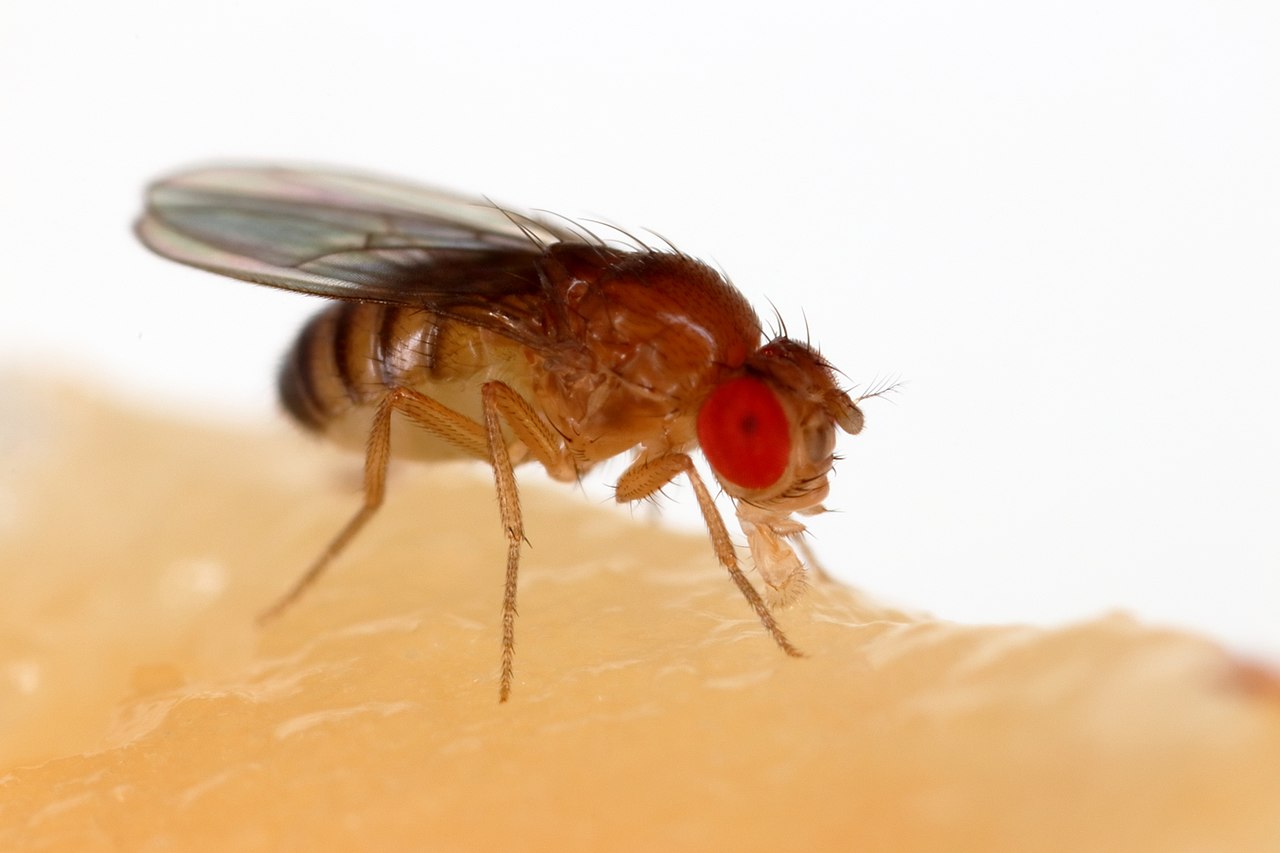
The fruit fly Drosophila melanogaster, a common subject of genetic experiments in the lab. The fly is feeding upon a piece of banana. Image by Sanjay Acharya (Wikipedia/Wikimedia Commons; Creative Commons Attribution-Share Alike 4.0 International license).
A similar range of studies are also being conducted on natural populations of organisms in the wild, including the famous example of the Galapagos finches (or, Darwin's finches) and their evolutionary responses to changes in environmental conditions (especially in terms of the shapes and sizes of their beaks, as illustrated below). The video below discusses a long term project that has been studying the evolution of the Galapagos finches in the field.
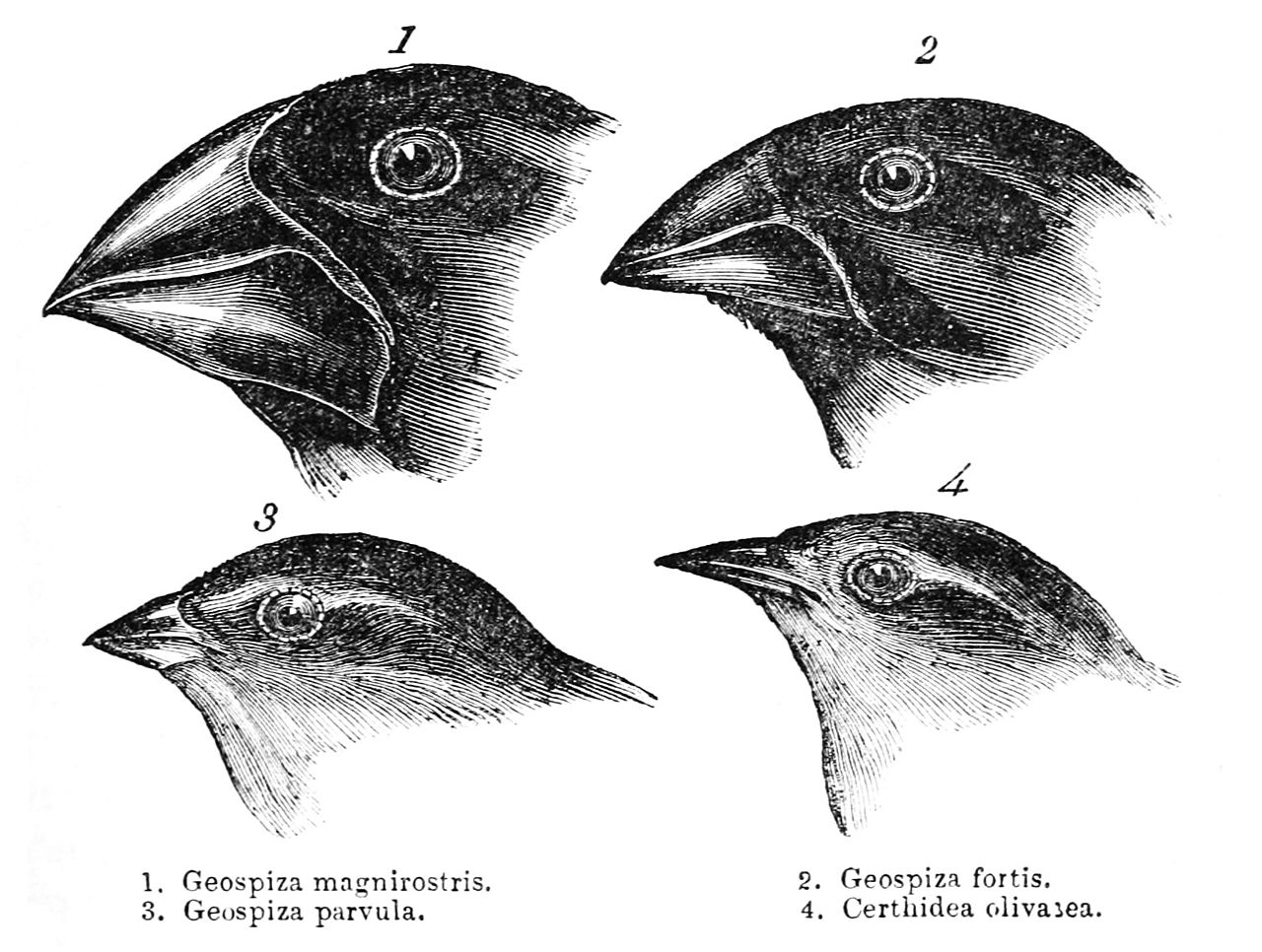
Drawings of different species of Galapogos finches from Darwin's (1845) book, Voyage of the Beagle (Wikipedia/Wikimedia Commons; public domain).
"Galapagos Finch Evolution" by HHMI BioInteractive Video (YouTube).
Other examples of modern-day evolution include the repeated evolution of antibiotic resistance in various bacterial populations, the declining average size of many fish species as larger fish are preferentially caught by humans, and numerous examples of plant and animal domestication (see the next section for additional information on such artificial selection).
One might remark that each of these types of studies provide examples involving small-scale evolutionary changes (e.g., changes within a species) and of course that is true. But there is also abundant evidence of large-scale evolutionary transitions. These come from two sets of sources: 1) the fossil record and 2) phylogenetic analyses of the body parts (morphology) and DNA of modern species.
The fossil record is replete with numerous examples of evolutionary transitions that have occurred, both in recent geological history and the distant past. One of the best examples comes from our own lineage, the hominids. The fossil record of the past 6 million years reveals the transition from chimp-like species with smaller average brain sizes to species that are increasingly human-like in appearance (i.e., bipedal), with larger average brain sizes (see also the speciation section of this chapter).
"Great Transitions: The Origin of Humans" by HHMI BioInteractive Video (YouTube).
The traditional, iconic view of human evolution is one of a monkey turning into an ape, which then turns into a caveman, and then a human. This view is everywhere in popular culture. As evidence, take a moment to do a Google Image search of the word "evolution." You will see countless examples of this. The same thing is shown in the evolution of Homer Simpson video below.
"The Simpsons Homer Evolution" from the television show, The Simpsons (YouTube).
This is not how evolution works, however. Evolution is a branching process, driven largely by geographic isolation of populations, which we cover later in this chapter in the section on speciation.
It is important to understand that humans did not evolve directly from the modern day chimpanzee. Rather we share a common ancestor with them that lived 5-6 million years ago, probably in Africa. This is depicted by the phylogenetic tree of relationships (or, cladogram) shown below. (Visit the DEAL pages on phylogenetics to learn how to read and interpret these trees.)
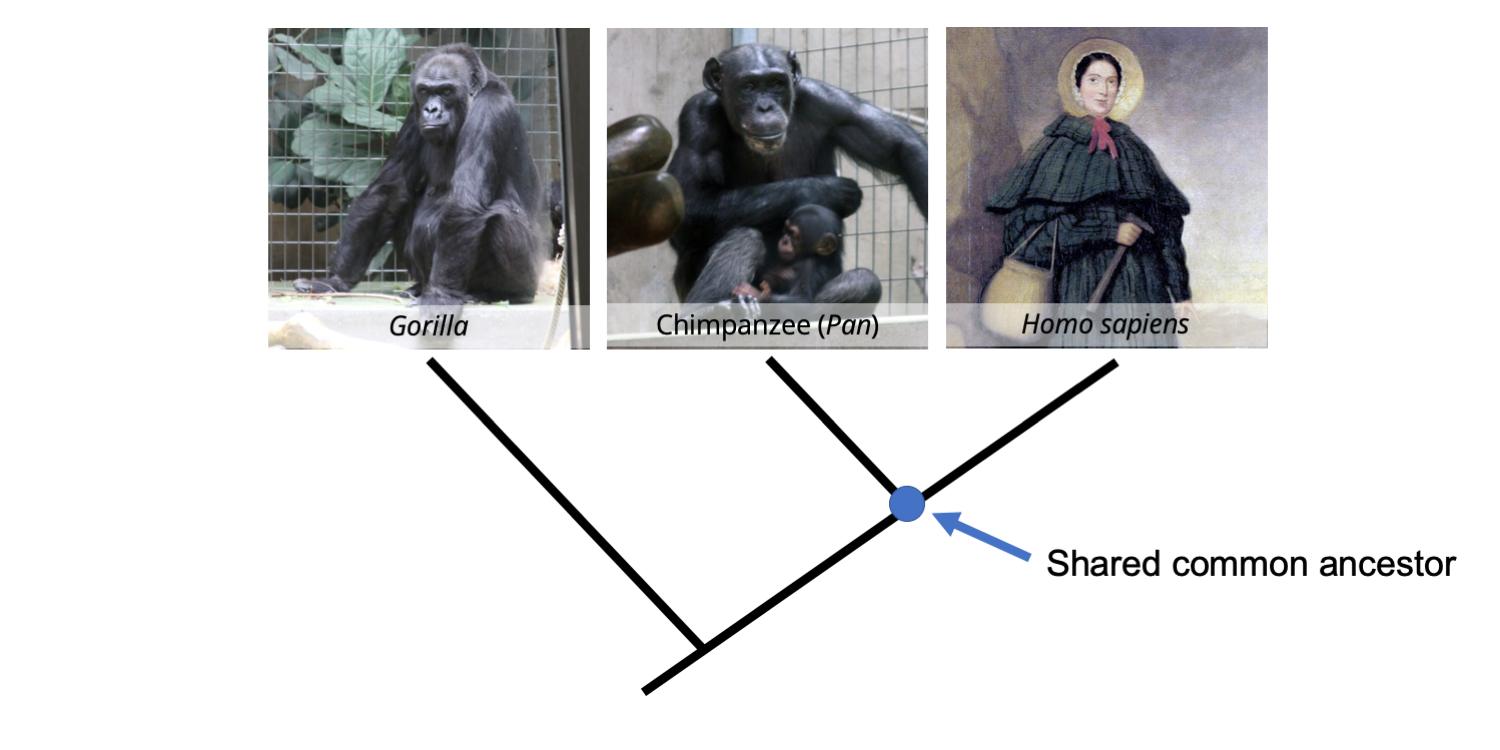
A phylogenetic tree depicting the relationships between a gorilla, a chimpanzee, and a human (19th century paleontologist Mary Anning; portrait public domain). Image by Jonathan R. Hendricks.
While chimps are our closest living relatives (this is well established by comparisons of the DNA of each species), we are far more closely related to species of ancient hominids that are now completely extinct. If any of those hominid species were still alive, we would say that they are our closest living relatives, not the chimpanzee.
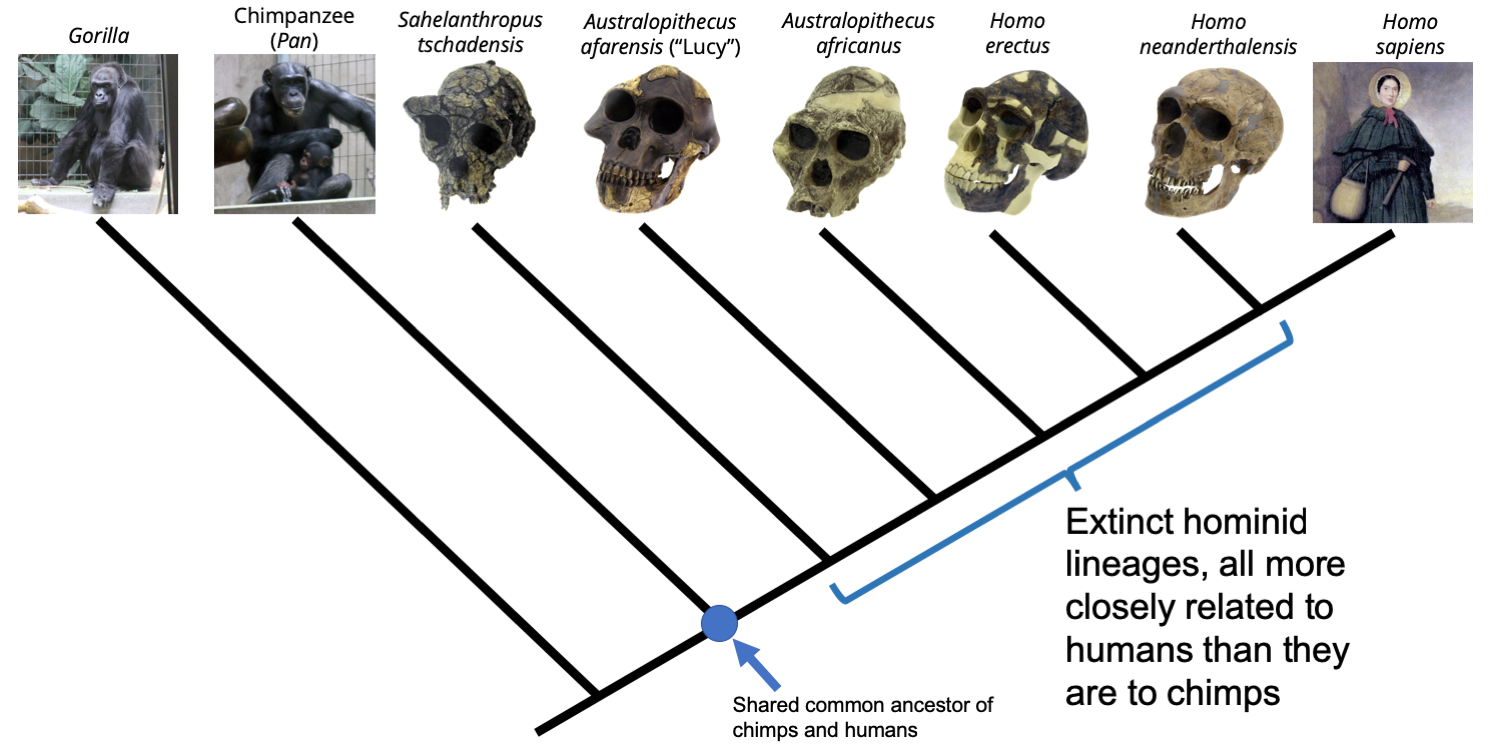
Phylogenetic tree depicting the relationships between gorillas, chimpanzees, humans (depicted by 19th century paleontologist Mary Anning; portrait public domain), and human-like relatives. Image by Jonathan R. Hendricks.
Another great example of a large-scale transition preserved in the fossil record is the initial transition of the vertebrates onto land during the Devonian period (about 375 million years ago). This transition is recorded by the discovery of fossils like Tiktaalik, which bears features of both fish and four-legged land animals (tetrapods). As we would predict, this transition occurred long before the origin of hominids, as hominids are the evolutionary descendants of these earliest land-dwelling vertebrates.
"The Origin of Four-Legged Animals" by HHMI BioInteractive Video (YouTube).
Not only did vertebrates move from the sea to the land, but there were also transitions from land back into the sea that happened hundreds of millions of years after the aforementioned Devonian origin of land vertebrates. These too are very well preserved in the fossil record. One example is the origin of whales from their land-dwelling ancestors.
When we compare the DNA of modern whales (including dolphins and orcas) to all other living mammals, we find that they share the greatest similarity with hippos.
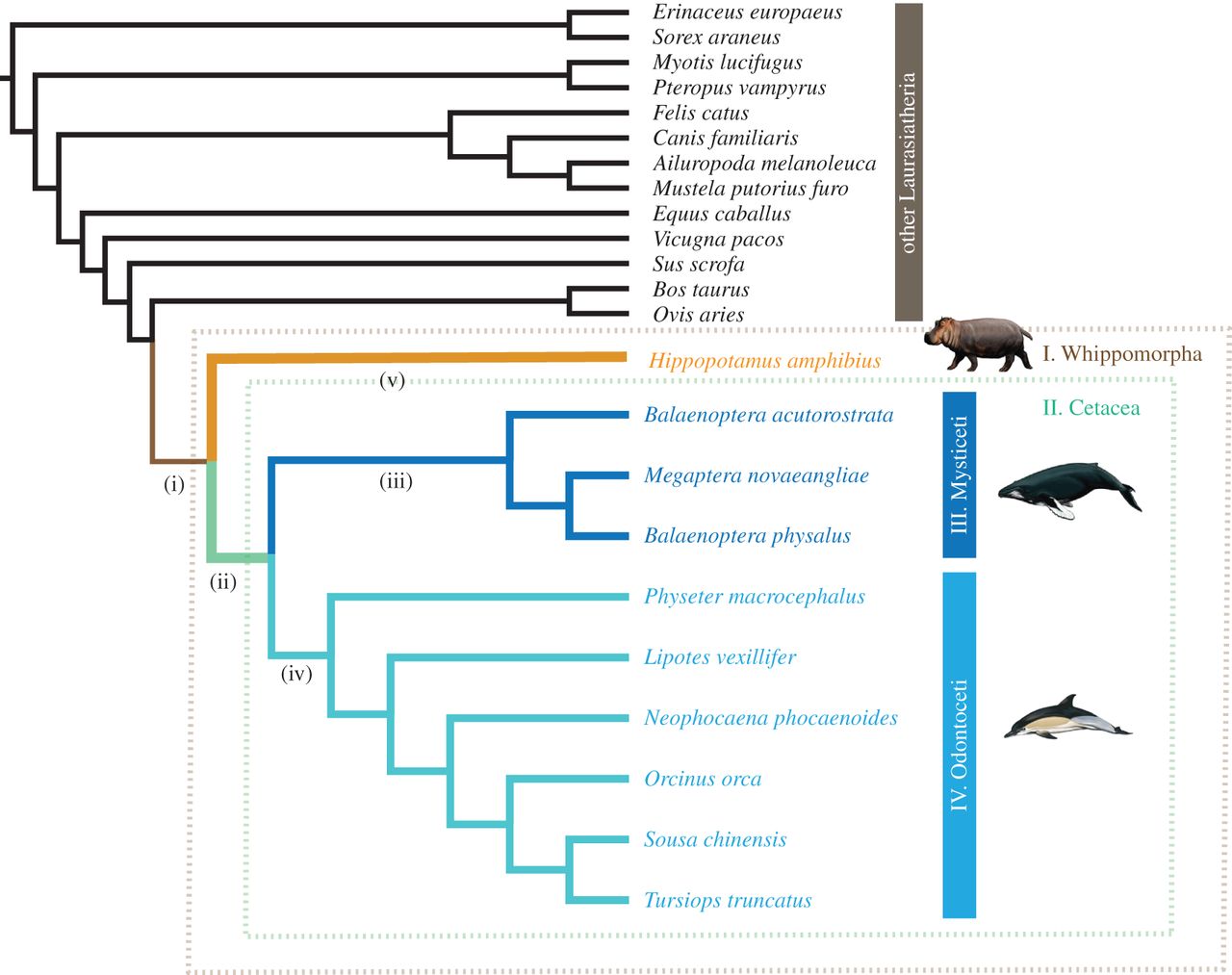
Image from Tsagkogeorga et al. (2015 in Royal Society Open Science). Original caption: "Evolutionary relationships among laurasiatherian mammals as used in molecular evolution analyses. The four clades tested for divergent selection are shown in colour and numbered in uppercase: (I) Whippomorpha (Hippopotamidae + Cetacea); (II) Cetacea; (III) Mysticeti and (IV) Odontoceti. Branches tested for positive selection are numbered in lowercase: (i) Whippomorpha (Hippopotamidae + Cetacea); (ii) Cetacea; (iii) Mysticeti; (iv) Odontoceti and (v) hippo." Creative Commons Attribution 4.0 International license.
Obviously, modern hippos and whales do not look very similar to each other. Moreover, whales did not evolve directly from hippos (just as humans did not evolve directly from chimpanzees). Instead, whales and hippos share a common ancestor that lived tens of millions of year ago. Some of the descendants of this common ancestor are highlighted in the video below. Note how these descendants become more-and-more whale-like over time, acquiring features that improved their ability to more efficiently move through the water (streamlined body, flippers, etc.).
"When Whales Walked" by PBS Eons (YouTube).
Although we could provide many more examples (e.g., the evolution of birds from theropod dinosaurs), the last one we will mention is the origin of arthropods. Arthropods are the phylum of animals that includes insects, spiders, centipedes, crustaceans, and other similar creatures (all of which have segmented external skeletons and jointed appendages). The origin and diversification of arthropods is very well recorded in the fossil record. In combination with DNA evidence, the fossil record shows us that arthropods are most closely related to “wormy” animals that molt their exoskeletons as they grow (all arthropods also molt). Examples of these "worms" include priapulids and kinorhynchs.
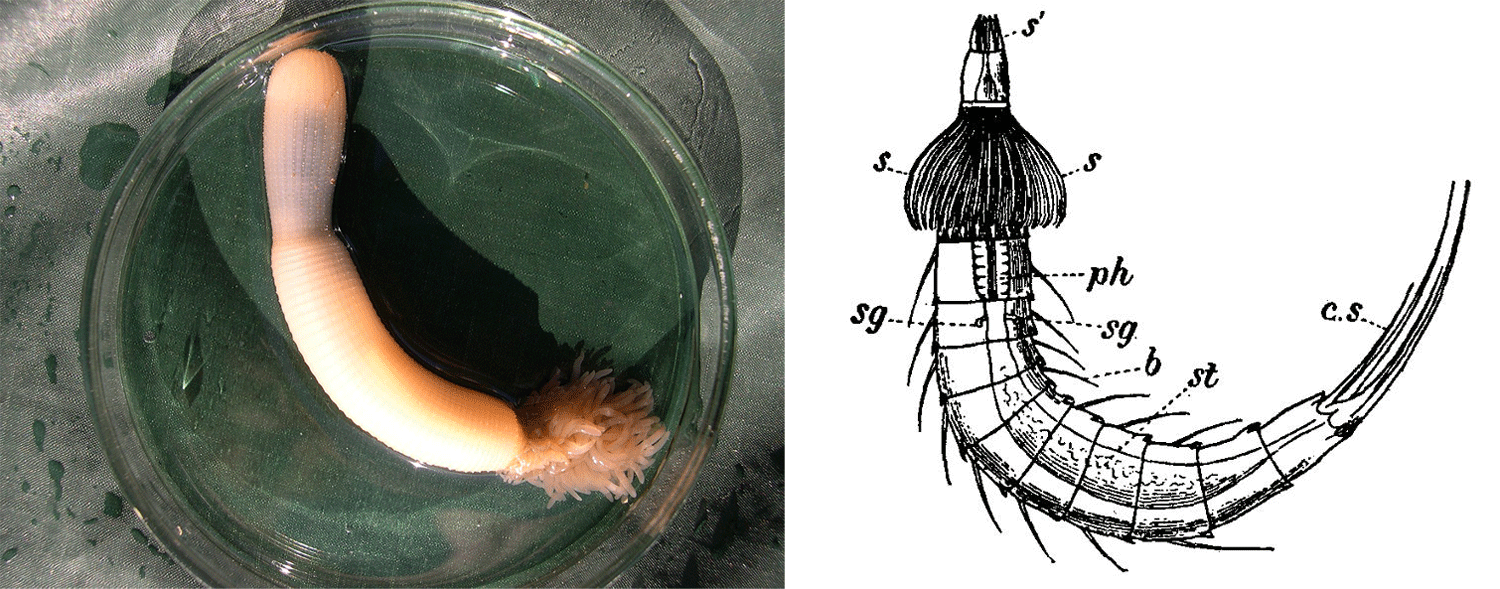
Left: the priapulid worm Priapulus caudatus; image by Shunkina Ksenia (Wikipedia/Wikimedia Commons; Creative Commons Attribution 3.0 Unported license). Right: drawing of a kinorhynch, from the Encyclopedia Britannica (11th edition, 1911) (Wikimedia Commons; public domain).
Fossil specimens from the Cambrian period have transitional features that help to bridge the gap between these living worm-like animals and groups of modern arthropods. Examples of these Cambrian animals include strange creatures like Anomalocaris and Hallucigenia.

Left: reconstruction of Anomalocaris canadensis; image by Tobu Tamura (Wikipedia/Wikimedia Commons; Creative Commons Attribution-Share Alike 4.0 International license). Right: reconstruction of Hallucigenia sparsa; image by Jose Manuel Canete (Wikipedia Wikipedia/Wikimedia Commons; Creative Commons Attribution-Share Alike 4.0 International license).
Tardigrades (or, if you prefer, water bears or moss piglets) are living animals that also show features of both worms like priapulids and also arthropods like crustaceans and insects. They are most remarkable for being able to survive extreme environmental conditions.
"Meet the tardigrade, the toughest animal on Earth" by Thomas Boothby and TED-Ed (YouTube).
The best approach for documenting and understanding the evolutionary connections between major groups of plants and animals is to combine information from both modern and fossil organisms in a phylogenetic context. Learn more about how phylogenetic trees are built and read here. Most of the organismal chapters of this textbook are arranged in a phylogenetic context to help you understand the relationships among particular groups, as well as the evolution of the features that define those groups.
Did Darwin discover evolution?
Darwin, who wrote On the Origin of Species, is certainly the individual most associated with the idea of evolution and most people assume that he is the first person to suggest that species have evolved over time. This is a major misconception.
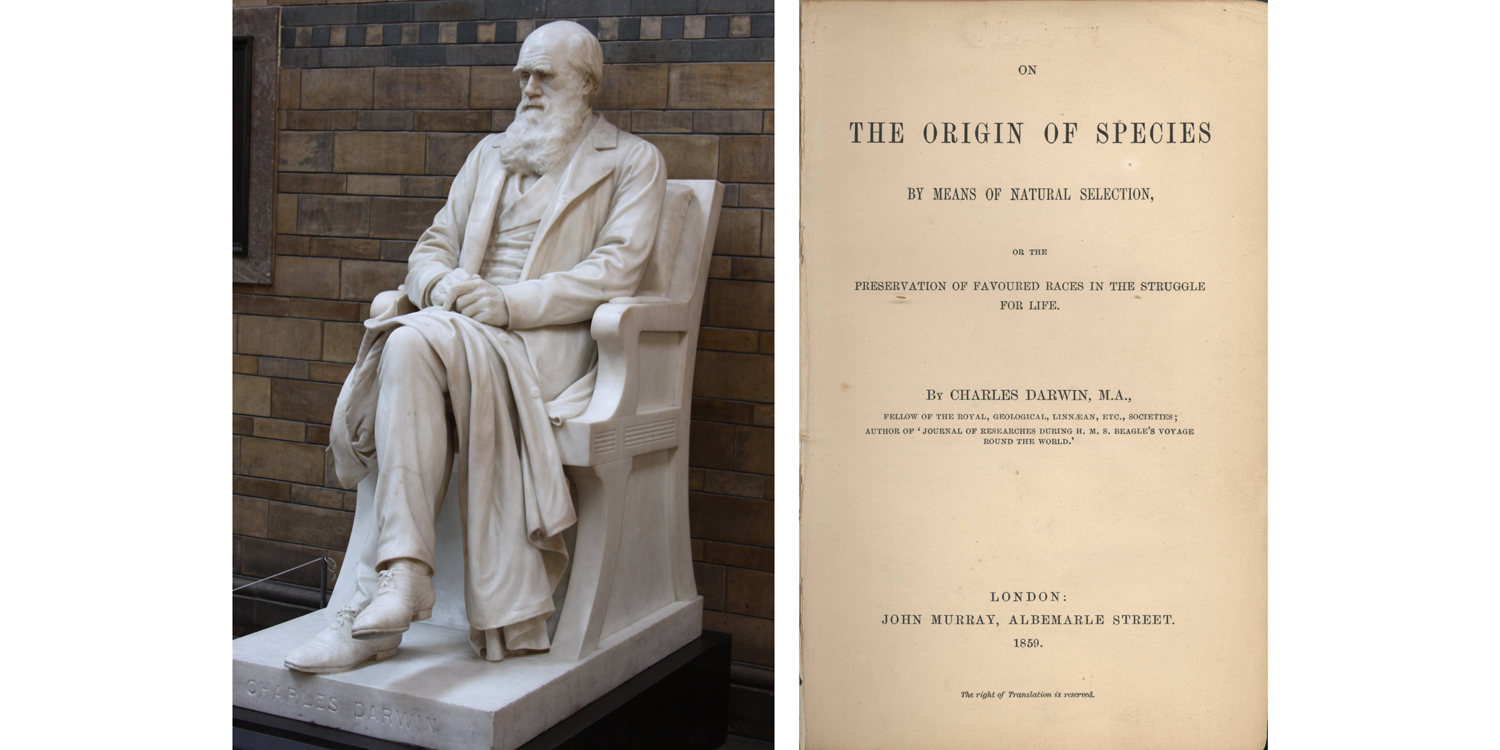
Left: a marble statue of Charles Darwin on display at the Natural History Museum, London. Right: title page of the first edition of Darwin's On the Origin of Species (Wikipedia/Wikimedia Commons; public domain). Image by Jonathan R. Hendricks.
Although Darwin certainly was a great thinker who contributed in very important ways to both biology and geology, he did not “discover” evolution (we will focus on what some of his crucial contributions were in the next section of this chapter).
In fact, for many centuries before Darwin, philosophers and naturalists speculated on the nature of species and whether they are static or instead change over time. For instance, ancient Greek philosophers like Anaximander and Empedocles were active in the 4th century B.C., and they reflected upon possible natural (i.e., not supernatural) explanations for the origins of species, though today we find their purported mechanisms for such origins strange. (They range from humans developing inside fish to a view that the different body parts of organisms naturally assembled—that is, random heads connected to headless bodies—until "perfect combinations were achieved" (Mayr, 1982, p. 302). Weird, but it was a beginning.
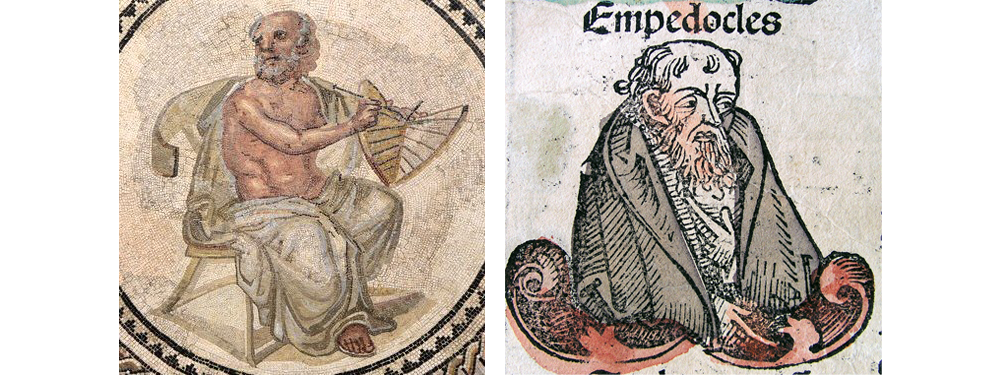
Left: Tile mosaic of Anaximander (Wikipedia/Wikimedia Commons). Right: Empedocles (Wikipedia/Wikimedia Commons; public domain).
Ideas regarding the origins of species may extend back even earlier, but we can’t say for sure. The reason we know about Anaximander and Empedocles is that they wrote their musings down and these writings survive to the present day. Furthermore, ideas on evolution were not just developed in Europe. Several Native American tribes have traditions that extend back many hundreds of years, possibly even thousands of years, that postulate that life forms have changed through time, and that present-day animals are the modified descendants of ancient ones.
It is clear though that there was a very long-time interval, stretching from the end of the Roman Republic in the first century B.C. to the growth of the enlightenment in the 17th century, when the concept of evolution received scant attention in Europe and elsewhere. The idea of evolution—and, for that matter, most other non-Biblical explanations for natural phenomena—were considered taboo for more than 1,000 years because learned individuals (those who today we might call philosophers or scientists) feared challenging the hegemonic dogma of the religious leaders of the Dark and Middle Ages.
The scene "She's a witch!" from the movie Monty Python and the Holy Grail (YouTube), which we presume at least semi-accurately portrays life in Europe life during the Dark Ages.
We enjoy studying the fossil record and evolution, but admit that the possibility of getting hideously tortured and or executed for even discussing it would be a pretty strong inducement for us to keep our research results to ourselves. We thus hesitate to too strongly chastise scientific practitioners from previous eras, although those who threatened to mete out such punishments are certainly worthy of excoriation.
In the late 17th century, Isaac Newton demonstrated that the physical properties and motions of the universe (from microscopic particles to celestial bodies) could be explained by natural laws and forces, rather than Divine micromanagement. This event, sometimes called the Newtonian Revolution, began to free science from the shackles of dogma and set the stage for the rise of biology in the late part of the 18th century and the early part of the 19th century. During this interval, numerous papers and books about the living world were published, and many scholarly societies were forming and having meetings, describing various lines of evidence that indicated that life had changed over time and that species might not be static. These events all happened before Darwin’s (1859) publication of “On the Origin of Species” and they influenced both him and other great scientists of the 19th century.
Perhaps first and foremost among these were the numerous works by the French naturalists Georges-Luis Leclerc, Compte de Buffon (1707-1788; published between the 1750’s and 1780’s) and Jean-Baptiste, Chevalier de Lamarck (1744-1829; published between 1801 and the 1820’s).
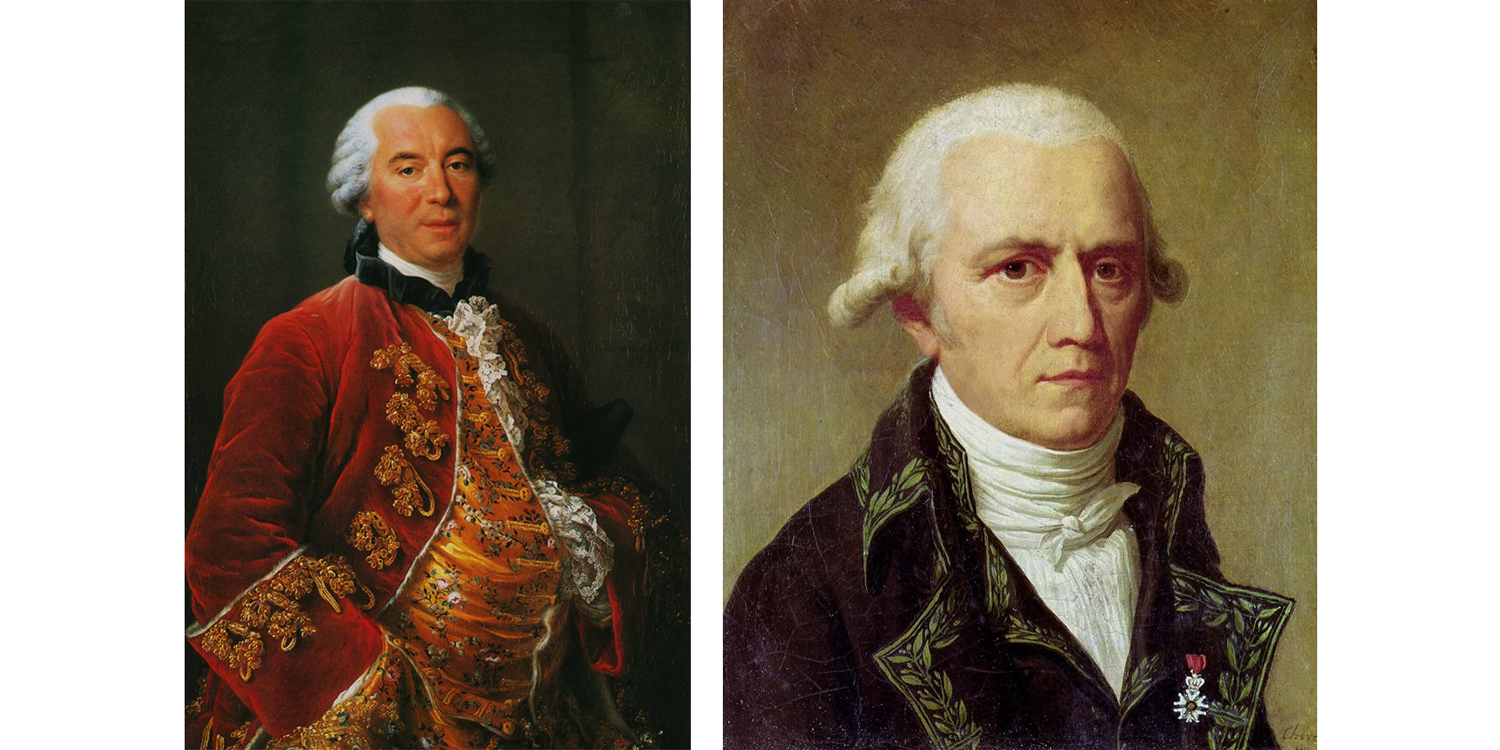
Left: portrait of Buffon by artist François-Herbert Drouais (Wikipedia/Wikimedia Commons; public domain). Right: portrait of Lamarck by artist Charles Thévenin (Wikipedia/Wikimedia Commons; public domain).
Each author outlined excellent evidence for evolution, although in Buffon’s many works it was at times equivocal and contradictory, as he occasionally asserted that the diversity of life had been produced by a creator. We can state with confidence, however, that by 1801 Lamarck was a fully-fledged evolutionist who had documented that evolution had occurred and proposed mechanisms for that pattern. Lamarck is often mentioned only in introductory courses as a biologist who got the mechanism for evolution wrong (one component of which was inheritance of acquired characteristics, which was often taught using giraffes as an example). While we know now that characters acquired in life (e.g., big muscles developed by weightlifting) are not passed on to offspring (babies are not born with big muscles, regardless of how ripped their parents are), Lamarck was way ahead of his contemporaries in understanding the biological world. Most importantly, Lamarck convinced many naturalists that evolution was true. Among these was Robert Grant, who became one of Darwin's most important teachers.
There are many important differences between Lamarck’s views on the processes most important for driving evolutionary change and those of Darwin, but each author held that there was a pattern of evolution: that all life was descended from a shared common ancestor. (Note that Darwin primarily described evolution as “descent with modification” [which is the definition we use above]. The only time that he used a word related to “evolution” in the entirety of On the Origin of Species was the last word of the book; see this passage at the top of this page.)
In the next section, we will explore Darwin's mechanism for evolutionary change (natural selection), as well as some related concepts that pertain to explaining the forms of organisms.
References and further reading
Bowler, P.J. 2009. Evolution: the history of an idea (25th anniversary edition). University of California Press, Berkeley.
Darwin, C. 1859. On the origin of species by means of natural selection (facsimile of 1st edition). Harvard University Press, Cambridge, Massachusetts.
Gould, S.J. 1989. Wonderful life: the Burgess Shale and the Nature of History. W.W. Norton & Company.
Lieberman, B.S., and R.L. Kaesler. 2007. Prehistoric life: evolution and the fossil record. John Wiley & Sons, New York, New York.
Losos, J.B. 2017. Improbable destinies: fate, chance, and the future of evolution, Riverhead Books.
Mayr, E. 1982. The growth of biological thought. Harvard University Press, Cambridge, Massachusetts.
Osborn, H.F. 1903. From the Greeks to Darwin: an outline of the development of the evolution idea. MacMillan, London.
Prothero, D.R. 2008. Evolution: what the fossils say and why it matters. Columbia University Press, New York, New York.
Saey, T.H. 2017. DNA evidence is rewriting domestication origin stories. Science News.
Stringer, C. 2012. What makes a modern human. Nature 485: 33–35.
Tsagkogeorga, G., M.R. McGowen, K.T.J. Davies, S. Jarman, A. Polanowski, M.F. Bertelsen, and S.J. Rossiter. 2015. A phylogenetic analysis of the role and timing of molecular adaptation in the aquatic transition of cetartiodactyl mammals. Royal Society Open Science 2(9).
Vrba, E. 1985. Environment and evolution: alternative causes of the temporal distribution of evolutionary events. South African Journal of Science 81: 229–236.
Vrba, E. 1993. Turnover-pulses, the Red Queen, and related topics. American Journal of Science 293: 418–452.
Weiner, J. 1995. The Beak of the Finch: A Story of Evolution in Our Time. Vintage.
Content usage
Usage of text and images created for DEAL: Text on this page was written by Bruce S. Lieberman and Jonathan R. Hendricks. Original written content created by Bruce S. Lieberman and Jonathan R. Hendricks for the Digital Encyclopedia of Ancient Life that appears on this page is licensed under a Creative Commons Attribution-NonCommercial-ShareAlike 4.0 International License. Original images created by Jonathan R. Hendricks are also licensed under Creative Commons Attribution-NonCommercial-ShareAlike 4.0 International License.
Content sourced from other websites: Attribution, source webpage, and licensing information or terms of use are indicated for images sourced from other websites in the figure caption below the relevant image. See original sources for further details. Attribution and source webpage are indicated for embedded videos. See original sources for terms of use. Reproduction of an image or video on this page does not imply endorsement by the author, creator, source website, publisher, and/or copyright holder.



